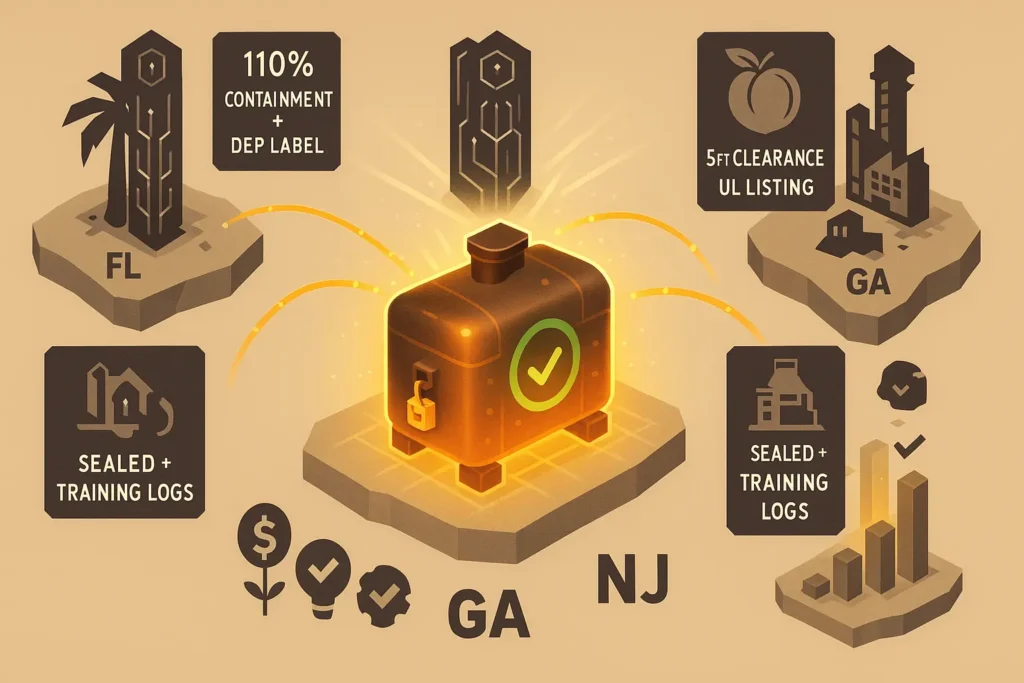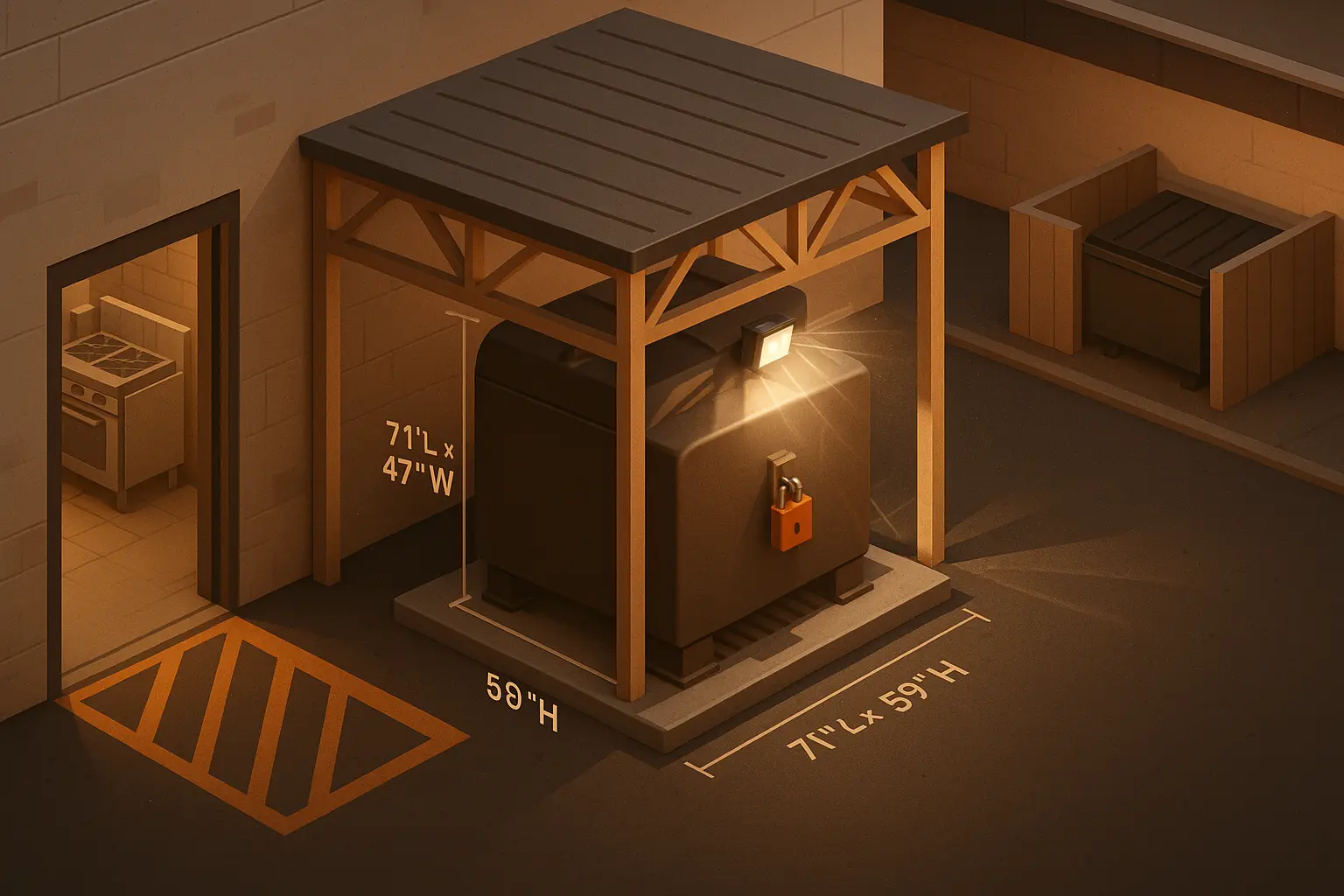Table of Contents
The Real Question Behind the Container
When your service line pushes 2,000 plates a day, used cooking oil (UCO) stops being trash and becomes a 200 gallon a week commodity, and a fire code liability if it sits in the wrong drum.
Florida, Georgia and New Jersey inspectors now ask where you store it before they ask how you fry it, because 30 to 35 % of sewer overflows trace back to wayward grease blockages. Choosing the right container size is the quickest route to pass inspection, deter theft and earn the $0.28 to $0.38 per gallon rebates common in our service hubs.

How Much Used Oil Do 2,000 Meals Create?
Start with the fryers. A standard 50 lb floor fryer holds about 50 lb (≈6.6 gal) of oil. High volume kitchens (100+ orders per day) replace that oil every 2 to 3 days. At 2,000 meals daily, you typically operate six 65 lb vats (80 lb max).
Each vat dumps roughly 20 gal every third day, or ≈200 gal a week. That figure aligns with OSU’s turnover study showing one full fryer volume added every eight hours of continuous frying. Use 200 gal/week as your planning baseline, then add a 20 % storm day buffer.
Which Container Fits That Volume?
| Enclosed Container | Net Capacity | Ideal Weekly UCO Volume | Typical Footprint | Notes |
|---|---|---|---|---|
| 140 gal lock lid steel | 125 gal | 90 to 140 gal | 36″ H × 33″ L × 27″ W | Fits tight alleys; slide grate lid resists theft. |
| 240 gal lock lid steel | 215 gal | 140 to 220 gal | 36″ H × 60″ L × 27″ W | One pick up a week; needs 12 ft truck clearance. |
| 300 gal UL 142 double wall | 270 gal | 175 to 250 gal | 71″ L × 47″ W × 59″ H | Meets SPCC & fire code secondary containment in one shell. |
For a 2,000 meal kitchen, the 300 gal unit (or dual 140s if space is segmented) gives three to four days of headroom without breaching the 80 % fill line that inspectors look for.

Code Snapshot: Florida, Georgia, New Jersey
- Florida DEP: containers >55 gal stored outdoors must be closed, labeled “Used Oil,” and either double walled or inside a berm holding 110 % of volume.
- Georgia Fire Code §607: >60 gal outside must sit 5 ft from combustibles, be UL listed, and include secondary containment.
- New Jersey local FOG programs require businesses to recycle UCO in a sealed barrel or bin and keep training logs on site.
- EPA 40 CFR 279 backs all three states: containers must be in good condition, closed except when adding oil, and clearly marked.
Translation: a lockable, UL 142 tank with built in pan ticks every box, no jury rigged pallets, no tarps.
Designing a Theft Proof, Weather Tight Storage Zone
Place the tank on level concrete, under a fixed awning or prefab lean to so rainwater never dilutes your oil’s rebate value; oxidation can shave 15 % off commodity pricing after 30 days. Motion sensor lighting and a commercial padlock deter siphoning, a rising problem in biodiesel markets worth $18B a year. Keep 5 ft clear on the service truck side; drivers won’t connect the vacuum hose if they must navigate boxes or pallets, leading to missed pickups and overflow fines.
Workflow: From Fryer to Sealed Tank
- Cool oil to 140 °F. Hotter oil flashes when residual water hits the tank.
- Wheel a 70 gal indoor caddy under the drain; its 12″ lid gives splash free access.
- Pump or gravity drain into the outdoor tank through a cam lock fitting: no open lids, no spills.
- Log the fill level; schedule pickup at 75 % capacity to stay within the 110 % containment rule.
Follow this routine and staff touch hot oil for less than 60 seconds a day.
Cost, Space & Upgrade Triggers
Weekly volume over 225 gal or staff losing >1 hour/week on manual transfers signals time to automate. A direct connect pump adds $75 to $150/month but cuts labor by 75 % and boosts rebate quality 20 to 30 %. Kitchens that expanded from 240 gal drums to closed loop systems recouped install costs in eight months through labor and rebate gains.
Choosing a Collection Partner That Pays You Back
- Pick a used cooking oil collection company (not a “hauler”) that:
- Supplies UL 142 or equivalent tanks at no charge.
- Provides digital fill level photos, handy proof during fire or health inspections.
- Offers hubs in every state you operate; Grease Connections services Miami, Atlanta and Carlstadt with 48 hour emergency swaps.
Ready to right size? Book a free on site assessment or see how savings stack up on our Miami used cooking oil collection service.
Key Takeaways & Next Step
- A 2,000 meal kitchen produces about 200 gal of UCO a week, so target a 300 gal UL 142 double wall tank (or twin 140s) for safe, code compliant storage.
- Keep the tank closed, labeled, and on concrete with 110 % containment, meeting EPA §279 and each state’s local add ons.
- Automate transfer when manual handling steals more than one paid labor hour per week.
- Partner with a recycler that pays rebates, not invoices.
- Schedule your grease room walk through today and turn tomorrow’s oil change into next quarter’s profit.









